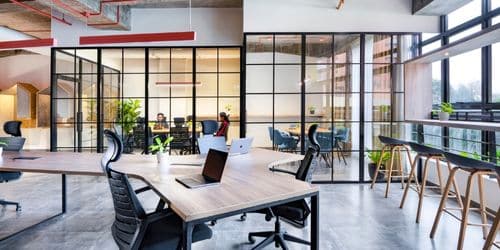What’s the ideal ratio of workspace to open space in your office? How can you arrange your business’s work environment for maximum efficiency? Office space planning can help you answer those questions and many more. In this article, we discuss everything business owners need to know including definitions, factors that affect the final arrangement, and tips for success to get the most out of their office space planning efforts. We’ll discuss cheap office space rent and commercial office space rent in this article. A tip about office space rent in Las Vegas is added to it. Enjoy the ride!
Read Also: COMMERCIAL OFFICE SPACE: Ultimate Guide On How To Find A Befitting Office Space
What Is Office Space?
It means a space that would provide the infrastructure system (office equipment and machinery necessary for a working space), furniture, internet services, telephony, video-conferencing, and conferencing services. It could also mean means all Taxable Square Feet other than that which is attributable to the Retail Space
Furthermore, it can be defined primarily as work areas for personnel, conference areas, reception areas, hearing rooms, drafting areas, etc. Minor storage areas, such as storage of miscellaneous supplies or stationary and file cabinet space within a private office or adjacent to clerical personnel are also included in “office space.”
Features of Office Space
Office spaces can offer some things that retail spaces cannot. Here are some of the features you get in an office:
- Foot traffic – Whether you offer highly specialized services or don’t meet with customers at all in person, an office space can have low foot traffic. The value of this is that it is quiet and provides an uninterrupted daily workflow.
- Parking – In an office, you will probably have fewer parking spots than you would in a retail building. Because you pay for spaces, if you don’t need the parking that comes with retail space, you may save money in an office.
- Visibility – Offices are typically on campuses, in buildings, or otherwise “off the beaten path,” at least relative to retail buildings. As commercial spaces go, they are less visible and may have minimal signage. While you can still post a logo, or be added to a menu, you won’t have the same level of visibility as a retail store.
- Accessibility – An office should be accessible but may span multiple floors, have narrow hallways, or be segmented into cubicles. Your office building may be further away from major roads or highways.
- Price per square foot – The average price per square foot for an office building is slightly lower than a retail building. There will probably be less wear and tear and you may sign a longer lease in exchange for a lower monthly payment.
Classifications of Office Space
Office spaces have been classified into three classes based on the aesthetics, age, amenities, and other infrastructures that make up a building:
#1. Class A
Class A office spaces are often brand new or properties that have been consistently improved or significantly renovated over time. Buildings under this category are usually of high quality, located in major cities, situated in choice areas, and have the highest grade of anesthetics and architectural designs. They are often leased by big companies or conglomerates and rental rates are relatively high due to the high quality of the buildings.
#2. Class B
Class B office spaces are almost as nice as class A office spaces except that they are usually older buildings that have been well maintained over the years. They are located in areas that used to be prime areas of the city as well as some parts of the current choice areas too, they tend to command average rental rates due to the average to above-average quality of the buildings.
#3. Class C
Class C office spaces are older buildings (over 20 years old) with old designs, aesthetics, and general quality often located in the least favorite parts of the city. They are often sought after by start-up businesses, are relatively few, require extensive renovations or reconstruction, have the lowest rental rates, take the longest time to lease, and are often targeted as re-development opportunities.
Types of Office Space
The following are the types of office space;
#1. Traditional Office Space
This is the most common type of office space and has been the ideal type for so many years. The common features of this office space are cubicles, conference rooms, a reception area, private offices, break rooms, and a mailroom. Traditional office spaces are often used by law firms, IT companies, financial institutions, and so on.
#2. Creative Office Space
This type of office space is known for its open layout feature. Collaboration, transparency, easy flow of communication and creativity, unity, etc. are some of the main goals of creative spaces, thus, the fewer cubicles and walls between departments. The common features found in creative spaces are wood floors, high and airy ceilings, large windows to let in natural light, kitchen and lounge for employees, and lesser private offices; they are often used by tech companies and start-ups.
#3. Co-working Office Space
This is the most flexible type often used by start-up companies, entrepreneurs, and freelancers in need of working environments with flexible rental terms. Co-working office spaces are usually several single small spaces housed in a building rented out to various individuals, thus all other features like meeting rooms, break areas, and desks are often shared by all tenants. However, rents are mostly on a monthly basis and offices are already furnished.
#4. Executive Suite
The executive suite office space is a co-working space with a more professional outlook that offers a relatively low monthly rental rate. They are usually fully furnished, pre-wired for phone and internet services, and have a common conference room, break room, and a reception area with a receptionist thereby giving it the perfect executive office layout and relieving tenants of planning stress.
#5. Flex Space
Flex office spaces are usually sought after by businesses that require both office space and a warehouse in the same place. Thus, the warehouse, reception area, meeting room, accounting department, and so on will all be under one roof with respective entrances to the main office and warehouse.
Office Space Rent in Las Vegas
Renting an office will be one of your biggest operating expenses as a business. You’re likely asking yourself — what overall office space cost can you expect to incur?
Well, office space rent in las vegas depends largely on the city and the size. In this post, we’ll cover a few basics of the relationship between square footage and price, and go over the various costs you can expect beyond the price per square foot.
#1. Office Space Lease Rates
When you search for office space online, you will see figures like “$52/SQFT.” That means rent is fifty-two dollars per square foot per year (or $4.33/SQFT per month). If you know the square footage of the office, you can estimate your annual and monthly rent. (The exception is on coworking platforms or on sites like PivotDesk, a shared space marketplace that connects those with extra space in their offices with those looking to enjoy the flexibility of shared space, where figures will be listed in terms of price per person or price per month.)
For the purposes of budgeting early on in the process, you don’t necessarily need to know the exact size you need. Consider that 100-150 square feet per person is the recommended average amount of space to allocate to each employee. A quick count of your employees can help you estimate a rent number that you can then start budgeting against. (To make this easy, we’ve created a square footage calculator that will help you get an accurate estimate of how much space your company needs.)
You should know, however, that this basic rent calculation is just that: a rent calculation. Office space comes with additional expenses factored into the lease. And even the rent and how it’s defined will need clarification.
The cost of can vary significantly within a city. Factors in the cost of an office include building class, building amenities (doorman, lobby, etc), and neighborhood.
#2. Average Commercial Lease per Square Foot
As we mentioned, the affordability of office space is largely contingent on your location. To give you a sense of how much commercial rent prices per square foot can deviate based on where you are, here’s how much office space costs in major metropolitan areas across the United States (as of 2023):
Market Average $/sq. ft.*
New York $85.20
Houston $31.40
Los Angeles $3.70*
Dallas $28.90
Washington, D.C. $59.70
Austin $48.40
Chicago $33.90
Atlanta $29.80
Boston $41.50
San Francisco $92.70
Note: Las Vegas prices per square foot are listed in terms of $/sq. ft. per month.
And even within cities, the office space cost can largely vary.
Cheap Office Space Rent
We can’t give you an absolute answer to the main point of this question, which asks: how much does it cost to rent a cheap office space? But for longer-term rentals, you’ll typically find that prices are listed per square foot of office space, per month, or per year. In general, you will find that small office spaces cost anywhere from $25 to $250 per hour in Las Vegas, with price fluctuations based on office location and included amenities in the mega city.
Commercial Office Space Rent
It should be no surprise that it’s more expensive to rent a commercial office space in some cities than in others. The average cost for office rental rates per square foot varies depending on where you plan to set up.
The most expensive city to rent office space is in New York. In New York, the average price for office space per employee costs about $14,800 per year. The average for office space per month in New York is about $6.16 per sq ft. San Francisco comes in a close second, with a monthly average cost of roughly $5.43 per square foot. That’s about $13,032 per year per employee.
Atlanta is the most affordable city with an average yearly cost to rent office space of $4,194 per employee per year. Most major cities have office space rentals, but if you live in a smaller city or rural area you may need to travel farther.
Factors That Affect Office Space Planning
Here are factors that affect office space planning:
#1. Budget
The cost of office space planning is always a consideration. Sure, you could go all out, spare no expense, and refurb your business’s workspace from top to bottom. In some cases, that may be necessary. In most cases, though, your business will be better served by setting a budget and sticking to it.
#2. Available Space
Available space is one of the major concerns when office space planning. Take into account the total square footage and then examine how your business allocates it. Is there a better way to arrange things?
#3. Capacity
Capacity, the number of people your space accommodates comfortably is another important variable to consider when planning to rearrange your office. Combined with your business’s available space, capacity sets the tone for all the decisions that follow.
If you don’t know exactly how many people you want your work environment to include, you can’t properly plan an effective arrangement.
#4. Desired Concept
There are many concepts available for your office space planning needs. Your team may be best served by one of these options:
- -Open office floor plans
- -Hot desks
- -Activity-based workspaces
- -Dedicated desks
- -Desk neighborhoods
- -Individual workstations
- -Flexible workspaces
- Do a bit of research and decide on the concept that’s the most effective for your business.
#5. Demand
Before getting too far into your office space planning, talk to your team to find out if they need a specific type of area that they don’t currently have (or can’t create from existing infrastructure). Doing so will ensure that any changes you make will support the way your employees want to work.
#6. Fixed Features
The fixed features in the building around you will dramatically affect your office layout and functionality. Map out and provide space around such elements as:
- -Fire exits
- -Doors
- -Structural components
- -Bathrooms
- -Windows
- -Steps
- -Entryways
Taking these fixed features into account at the beginning of the process will help you avoid last-minute “improvisations” that may detract from the effectiveness of your layout.
How Much Should I Budget for Office Space?
Pricing depends on many factors, but the average rental cost per square foot you see could be anywhere from $5-$60.
Why Is Office Space So Cheap?
Cheap office space is usually cheap because the landlord hasn’t invested a lot of money into the space itself. Maybe the owner got a deal on the property and it’s one of many commercial properties he or she manages.
Is It Ok to Live in an Office Space?
While it may be tempting to sneakily live in your rented commercial space, it is generally not a good idea to do so. This is because you could potentially face legal consequences for violating your lease terms or local zoning laws.
Is Office Space Still a Good Investment?
Commercial office spaces usually have high returns depending on the state of the property. The demand for offices by the growing business is huge, and you can easily get a quality tenant for a long-term lease. You can also invest in servicing the offices to increase their rent prices.
How Much Office Space Do I Need for 20 People?
Here is the quantity of space you need for 20 people:
- Small meeting room (2-4 people) = 100 sq ft.
- Large meeting room (4-8 people) = 150 sq ft.
- Board room (15-20 people) = 220 sq ft.
How Do You Calculate the Cost of Office Space?
Here is how to calculate the cost:
- -Count up the number of people you need to accommodate.
- – Consider carefully whether you want to allow for growth
- -Choose between flexible serviced and longer-term office space
- -Consider how you want to use your new office space.
This will help you in determining the kind and cost of office space you want
Final Thoughts
Finding the right office requires compromise, but you need to be clear from the outset on your non-negotiables and budget – and stick to them. Each type of rental agreement has its own benefits and drawbacks, but many small businesses opt for co-working spaces or serviced offices where a lot of the infrastructure is taken care of. Lean on external help where you can, especially if leasing your own space. It can help with everything from working out your budget to negotiating the terms of your contract.
Related Articles
- Creative Solutions For Optimizing Office Layout
- BUSINESS IN THE NEW NORMAL: 5 Trends Redefining the Business World
- OFFICE MANAGEMENT SYSTEM: Best Free and Paid Options In 2023
- 3 Reasons Retailers Should Partner with Money Transfer Services
- COMMERCIAL LEASE: Definition, Requirement, Process & Guide






